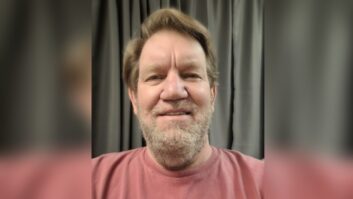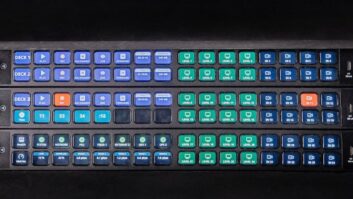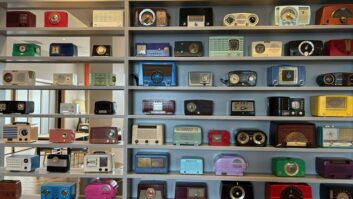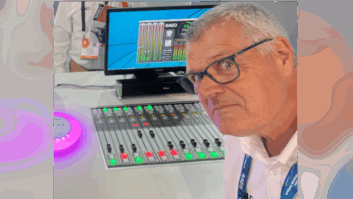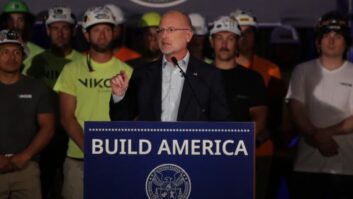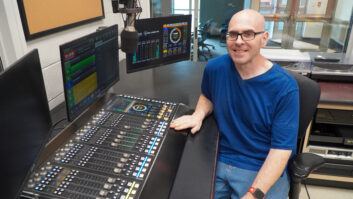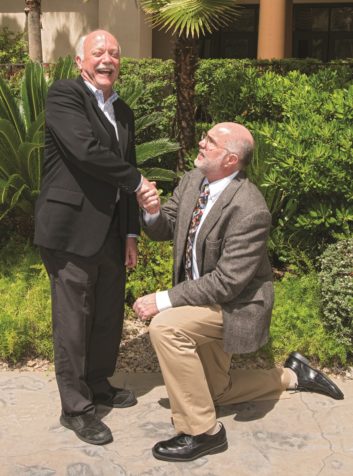
Dan Houg made an unusual entry into the field of radio engineering in 2004. He was in his mid-40s, having never even been in a radio facility before.
That did not prevent him from working successfully on several major projects, nor from becoming president of the Association of Public Radio Engineers. But after 17 years he has moved on to a different venture.
Radio World asked him about that and about his tenure as chief engineer of Northern Community Radio in Minnesota, a two-station network consisting of KAXE(FM) in Grand Rapids and KBXE(FM) in Bagley, near Bemidji.
Radio World: Dan you posted on PubTech that you were about to “cease to be a broadcast engineer and become a semi-normal human being.” How does it feel to have made that big decision?
Dan Houg: I knew about a year ago that I wanted to wrap up my 18 years in broadcast and work on restoration projects of vintage electronics, motorcycles and vehicles at home.
However, KAXE had a construction permit for increasing tower height that was expiring soon. I had always intended to see that project through to completion, but funding delays kept pushing construction back until this April [2021], when I could finally start purchasing.
In May, I made the decision to leave at the end of October, hoping the project would be done but needing to set a date for myself to leave.
The tower crew finished up Friday afternoon, Oct. 29. I turned the new plant on at 3 p.m. and drove home for the very last time at 6 p.m. after a 13-hour day.
It feels incredible to finish this project that started over three years ago, get it on the air and be able to retire the day it is operational. It is exactly the right time to leave.
RW: What are your plans?
Houg: Well, I joke with staff that I need to be like the 17-year cicada and go underground and not be seen nor heard from. Being a small shop, I’ve been in 24/7/365 contact for the last 18 years, literally not having my phone off for close to two decades, so I need to hide for a while to shed some stress. My wife knows all too well the 2 a.m. voice of the Sine Systems and Davicom remotes.
Financially, I still need to bring in some income, so I call this “leaving radio” more than retirement. When I’m in my home shop I’m in my “happy zone” and will earn a few dollars fixing things.
RW: What is the FixIt Workshop?
Houg: The Fixit Workshop (thefixitworkshop.com) is my new venture to switch gears away from broadcast.
As with so many of us engineers, I’m good at fixing things whether it is diagnosing a fire-breathing 25 kW tube transmitter, setting up a microwave link or repairing the HVAC system. Now I’ll turn to restoration of vintage guitar amps, I have a pallet of 1960s European tabletop tube radios that need refurbishing, and I enjoy working on the big Sansui, Fisher and Marantz solid-state receivers from the 1970s.
I have two VW Westfalia camper vans to restore getting ready to sell one of them, and all sorts of projects have come my way from putting a new engine on a log splitter, welding up a maple syrup stove and sap evaporator to repair of an old slot machine. I have a particular fondness for 1980s Mercedes Benz diesels and am always on the hunt another one.
Our service as “do it all” engineers really reflects a skill set that is apparently in short supply in a small community. I nostalgically like to think of myself as Luis, the Fixit Shop owner on the children’s television series “Sesame Street.” Working on well-made appliances like the Sunbeam T20 Automatic Radiant Control Toaster, an incredible piece of American engineering, is so rewarding for me.
RW: Is it true you’d never been in a radio station when you started your KAXE job in 2004?
Houg: Yes. My friend, Maggie Montgomery, was the general manager of Northern Community Radio, and the previous engineer had left. I decided to leave a very nice government job that was sucking the soul out of me and try my hand being KAXE’s engineer. Straight up learning curve. I have so much respect and admiration for the folks that have been in radio their entire lives and have such a good grasp on the technology. I’m just getting to the point where I feel like I have a handle on some things!
RW: And here you were doing a buildout of a 100 kW FM.
Houg: This last project was a complete replacement of our tower, transmitter plant-plus-shelter, and microwave link.
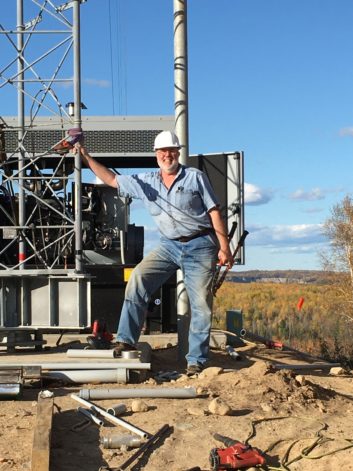
KAXE went on air in 1974, but the original tower went down in 1984 when a truck was putting a load of Class V on our tower road, and the raised gravel box snagged the lowest guy spanning over the road and brought the tower down.
When it was replaced, I don’t think the management at the time communicated to Pirod that in addition to our 100 kW 12-bay antenna with radomes, there would be ANOTHER 100 kW tenant with a 10-bay with radomes, all interleaved in the top 100 feet of the tower.
We had a tower analysis performed a few years back, because every tower maintenance crew that came out would say “Man, that tower looks overloaded.” The engineering report stated the tower was in danger of failing, even if bare with no antennas, and that it did not pass current standards for a 40 mph wind!
So as part of a long-term infrastructure improvement project, we knew it had to be replaced. We got a construction permit to go from 315 to 499 feet, and got to work raising money.
The new tower is on the same site as the old tower, 15 feet away, and the new tower was used to destack the old tower.
Now we have an ERI guyed tower that meets current standards and I sleep much better. I worried every night with high winds that the old one would come crashing down.
We have a Nautel NV30LT-N transmitter being supplied program material using a GatesAir IP Link 200 with dual IP paths of land fiber and a licensed 11GHz link, an Orban 8700i processor and a gorgeous Tunwall switch controller for the Dielectric 6000 series switch that eliminates an old patch bay (which was mounted at the perfect height that every generation of engineer has bonked his head on).
I reused our old Electro-Impulse 25 kW dummy load, having cleaned it, replaced the power cord and fixed the air flow switch. It works great except it smells like mice when it gets hot.
RW: What other accomplishments are you proud of from the past 17 or 18 years?
Houg: Through the financial genius of our former general manager, we’ve built new studios at KAXE in 2005, and added the new station KBXE in 2012 with full studios at 50 kW with a new ERI 499-foot tower.
I’ve done three towers and two studios now. My first tower, a 90-foot self-standing, taught me the importance of soil borings I’d neglected to obtain; it became the “STL tower from hell” after they found 6 feet of muck below the surface that required much excavation and foundation support.
Then with the KBXE 499-foot tower I learned that every large project takes a serpentine path, despite laying out the process linearly. It nearly killed me with stress with twists and turns in everything from siting, property acquisition and construction.
This last tower project I knew there’d be twists and turns. When an obstacle would come up I tried to say “Okay, let’s figure this out.”
There’s an old adage that every engineer should return to the first studio they built and apologize. So true with KAXE. There’s things that I was able to do much better on my second studio for KBXE including my own plan for sound isolation that a very highly paid architect did so poorly at the KAXE studio.
RW: Briefly tell us about your career before you came to this job.
Houg: Well, I started working running carnival rides, so don’t disparage those folks!
I worked for the Minnesota Department of Health for 17 years doing health care facility inspections, food and lodging inspections, and ended up in water quality doing testing and providing technical assistance for public water supplies.
I have a degree in social work, one career in health and another in broadcast; and I’ve just now figured out what I want to do in retirement!
RW: You mentioned a couple of people in your post as having been helpful in the radio part of your career.
Houg: Having zero radio background when I started, I needed a lot of help building a new studio within eight months of starting employment. I was in over my head.
A former engineer of KAXE, Shane Toven, was a font of information for the studio build and programming of our Logitek and ENCO systems. Many know how brilliant Shane is, and he had installed KAXE’s first satellite system, an SOSS, at age 14 as a nerdy kid looking for a place to hang out after school.
As projects kept coming and I was buying equipment, I ended up with a career-long relationship with SCMS salesman Jim Peck. Jim steered me to good equipment decisions and helped me think through projects to account for all the pieces. Having the ability to talk to a knowledgeable sales rep versus scrolling through web pages was so crucial in making the right decisions.
And I’d met Gray Haertig of Haertig and Associates at my first Public Radio Engineering Conference. I noticed this loud man in an Aloha shirt in the front row brilliantly interacting with speakers who then got up and gave a stunning presentation himself.
I’ve used Gray for our RF engineering and FCC filing since that time and am indebted to his generosity and knowledge as well as friendship. Shane, Jim and Gray have told me to breathe when needed, gotten me out of jams and given great advice, some of which I’ve taken and foolishly disregarded the rest. They are great friends.
RW: You’ve been active in the Association of Public Radio Engineers. How is the organization holding up, through the many months of the pandemic?
Houg: The APRE Board comprises station staff, industry reps and organization members, all of whom saw their workload and workflow drastically change over the last two years.
The APRE has two very important strengths that keeps it thriving. First, the board members themselves are incredibly committed radio professionals who are task-oriented and work together as a cohesive group. It has been my great pleasure to be part of this organization with such highly functional people, including our current Board President Victoria St. John as well Jobie Sprinkle and Paxton Durham.
The second strength is that being a volunteer organization unlike a manufacturer or vendor, the APRE doesn’t HAVE to make money or put on conferences to stay afloat. As they negotiate conference postponements and cancellations due to the pandemic, the assets and resources are not depleted.
The APRE is meeting actively all through the pandemic and is ready to bring the Public Radio Engineering Conference back in full.
RW: What else should we know?
Houg: If I could impart any passing wisdom to engineers, it would be to feel free to ask the stupid questions. Seek help, ask advice and admit you don’t know something as there are brilliant people willing to help you.
Dan Houg invites hearing from readers by email to [email protected].
